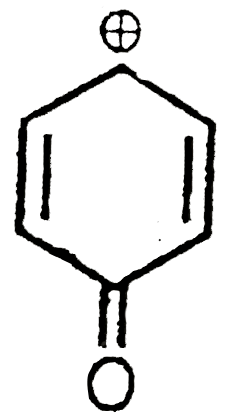Which of the following species is not aromatic ?




The correct Answer is:B
To determine which of the given species is not aromatic, we need to apply the criteria for aromaticity. A compound is considered aromatic if it meets the following three criteria:
1. Cyclic Structure: The compound must be cyclic.
2. Planarity: The compound must be planar to allow for overlap of p-orbitals.
3. Hückel's Rule: The compound must have (4n + 2) π electrons, where n is a non-negative integer (0, 1, 2, ...).
Now, let's analyze the options provided in the question step by step:
Step 1: Check for Cyclic Structure
- Ensure that all the given species are cyclic. If any of the species is not cyclic, it cannot be aromatic.
Step 2: Count the π Electrons
- For each cyclic species, count the total number of π electrons. This includes π electrons from double bonds and any lone pairs that participate in resonance.
Step 3: Apply Hückel's Rule
- For each species, check if the total number of π electrons fits the formula (4n + 2). If it does, the species is aromatic; if it does not, it is not aromatic.
Step 4: Check Hybridization
- Confirm that all atoms in the ring are sp² hybridized. This is important for the overlap of p-orbitals necessary for aromaticity.
Example Analysis
Assuming we have four species to analyze:
1. Species A: Cyclic, 6 π electrons (n=1) → Aromatic
2. Species B: Cyclic, 10 π electrons (n=2) → Aromatic
3. Species C: Cyclic, 8 π electrons (does not fit 4n + 2) → Not Aromatic
4. Species D: Cyclic, 10 π electrons (n=2) → Aromatic
Conclusion
From the analysis, Species C is the one that does not meet the criteria for aromaticity because it does not satisfy Hückel's rule.
Final Answer
The species that is not aromatic is Species C.
---
2. Planarity: The compound must be planar to allow for overlap of p-orbitals.
3. Hückel's Rule: The compound must have (4n + 2) π electrons, where n is a non-negative integer (0, 1, 2, ...).
- Ensure that all the given species are cyclic. If any of the species is not cyclic, it cannot be aromatic.
- For each cyclic species, count the total number of π electrons. This includes π electrons from double bonds and any lone pairs that participate in resonance.
- For each species, check if the total number of π electrons fits the formula (4n + 2). If it does, the species is aromatic; if it does not, it is not aromatic.
- Confirm that all atoms in the ring are sp² hybridized. This is important for the overlap of p-orbitals necessary for aromaticity.
Assuming we have four species to analyze:
2. Species B: Cyclic, 10 π electrons (n=2) → Aromatic
3. Species C: Cyclic, 8 π electrons (does not fit 4n + 2) → Not Aromatic
4. Species D: Cyclic, 10 π electrons (n=2) → Aromatic
From the analysis, Species C is the one that does not meet the criteria for aromaticity because it does not satisfy Hückel's rule.
The species that is not aromatic is Species C.
Topper's Solved these Questions
- GOCBOOK - MOTIONCHAPTER - GOCEXERCISE - Exercise - 2 (Level - II)
114 Videos
- GOCBOOK - MOTIONCHAPTER - GOCEXERCISE - Exercise - 3
44 Videos
- GOCBOOK - MOTIONCHAPTER - GOCEXERCISE - Exercise - 1
30 Videos
- GASEOUS STATE BOOK - MOTIONCHAPTER - GASEOUS STATE EXERCISE - EXERCISE-4( LEVEL-II)
19 Videos
- GRIGNARD REAGENTBOOK - MOTIONCHAPTER - GRIGNARD REAGENTEXERCISE - EXERCISE-2
16 Videos
Similar Questions
Knowledge Check
Which of the following species is aromatic ?
A B
B C
C D
D
Which of the following species is aromatic ?
A B
B C
C D
D
Which of the following species is aromatic :
A B
B C
C D
D
